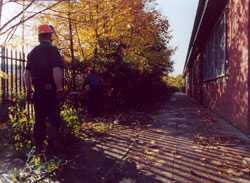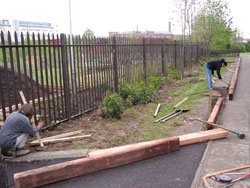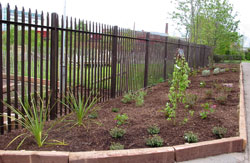the shrub garden
A service station for bees and butterflies
 When we first started working on the garden in 1998, we had no particular plans for this area. It actually sits just outside the wildlife garden, but runs alongside the pond and meadow area and interrupts the view to the garden from the classrooms. It was a muddy strip of grass bordered by some, by now, big trees – mostly Norway maple and rowan.
When we first started working on the garden in 1998, we had no particular plans for this area. It actually sits just outside the wildlife garden, but runs alongside the pond and meadow area and interrupts the view to the garden from the classrooms. It was a muddy strip of grass bordered by some, by now, big trees – mostly Norway maple and rowan.
Because there was no barrier between the grass and a footpath, the children had used the grass as a path. This, combined with the shade cast by the trees, meant the grass was far from lush! The trees also blocked most of the light reaching the classrooms.
 There was nothing for it but to chop down some trees! In the woodland area we had been planting trees, but here we needed to remove some – trees can become a nuisance if planted in the wrong place!
There was nothing for it but to chop down some trees! In the woodland area we had been planting trees, but here we needed to remove some – trees can become a nuisance if planted in the wrong place!
Armed with a chainsaw, we removed about 20 trees (most of the maples and a couple of larch), leaving the smaller rowans with much more space. The job was hardly made easier by the vicious tangle of spiny, climbing roses wrapped around the trees and the fence between this space and the wildlife garden.
It all looked quite drastic compared to what was there before, but the amount of light that now flooded the classrooms more than made up for this. We also had a cunning plan!
 In March 2001, with a visit by President of Ireland, Mary McAleese, iminent, we embarked on a tidy up and replanting of the area. Instead of trees, this time we wanted to introduce some ornamental plants to provide colour and, most importantly, flowers for insects. Bees, butterflies and moths, beetles and hoverflies (amongst others) would find the shrub garden very tempting as a spot to stop and feed on the pollen and nectar provided by the flowers. We chose plants that would flower the whole year round, to supplement what insects would find in the wildlife garden.
In March 2001, with a visit by President of Ireland, Mary McAleese, iminent, we embarked on a tidy up and replanting of the area. Instead of trees, this time we wanted to introduce some ornamental plants to provide colour and, most importantly, flowers for insects. Bees, butterflies and moths, beetles and hoverflies (amongst others) would find the shrub garden very tempting as a spot to stop and feed on the pollen and nectar provided by the flowers. We chose plants that would flower the whole year round, to supplement what insects would find in the wildlife garden.
Once again, a team of children, teachers, parents and volunteers spent a long weekend digging, edging, planting and mulching the area with the new (small) plants, many railway sleepers and a huge pile of chipped bark!